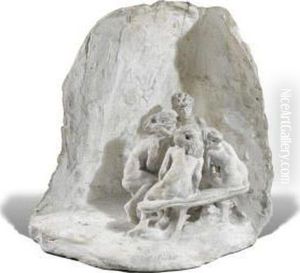Camille Claudel Paintings
Camille Claudel was a French sculptor and graphic artist, born on December 8, 1864, in Fère-en-Tardenois, Aisne, France. She is known for her figurative works, which often conveyed a sense of movement and emotion. Claudel was talented from a young age and pursued her passion for art despite the social constraints on women during her time.
In 1881, Claudel moved to Paris to continue her education and soon began working with Alfred Boucher, a friend of the family and an established sculptor. His guidance was crucial to her early development as an artist. When Boucher relocated to Italy for a period, he arranged for his pupil to study with Auguste Rodin, who was already a prominent figure in French sculpture. Claudel quickly became a source of inspiration, model, collaborator, and lover to Rodin. The complex and tumultuous relationship between the two artists would go on to be a defining element of Claudel's life and career.
Her works include 'The Waltz' (1892–1905), 'The Mature Age' (1893–1900), and 'The Wave' (1897). Claudel's sculptures often reflected the emotional aspects of her life, including her intense and difficult relationship with Rodin. She struggled to gain recognition independently of her mentor and lover, particularly as a woman in a male-dominated field.
Claudel's later years were marked by tragedy and hardship. By 1905, her behavior became erratic, and her family became increasingly concerned about her mental health. She destroyed many of her statues and lived in seclusion and poverty. In 1913, her family committed her to a psychiatric hospital in Ville-Évrard after she was diagnosed with schizophrenia. Despite the pleas for her release, both from Claudel herself and from doctors who insisted she was sane, her family refused to allow her to leave. She remained in institutional care for 30 years until her death on October 19, 1943, in Montdevergues Asylum, Vaucluse.
The recognition of Claudel's artistic genius was largely posthumous. Her works are now celebrated for their innovation and expressive power, and her life has been the subject of numerous books, films, and exhibitions. Today, Claudel is recognized as a pioneering sculptor who broke new ground for women in the arts.
